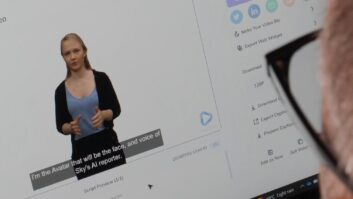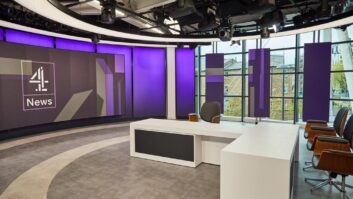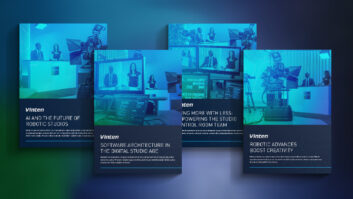
Al Sharqiya, Iraq’s first privately owned satellite channel, was launched in March 2004 with a mixture of news, current affairs and light entertainment shows. As well as studios in Baghdad and Dubai, the channel operates news bureaux in a number of international cities. Philip Stevens reports.
The UK operation is located in west London and includes a three-camera studio, MCR and an Orad 3D realtime virtual studio system. Normally, the studio is in use for three hours a day, seven days a week, broadcasting a news programme to its satellite and web audience. However, the studio can also to be used as a backup if the channel has problems broadcasting from its other facilities in the Middle East.
Alongside the studio facilities, the channel operates a number of news crews using DVCam equipment for location use. Earlier this year, in order to handle an expansion of its London operation, Al Sharqiva (the phrase means ‘The Eastern One’) installed a complete end-to-end digital newsroom system.
“We were planning to build a state-of-the-art newsroom system that would allow us to deliver major news stories in an efficient and flexible manner,” explains Ahmed Bin Afif, the station’s chief engineer. “We looked at a number of vendors, and now we have a news solution that not only meets our current needs, but also can be easily expanded, as required.”
This newsroom technology is centred around a workflow designed by Tyrell CCT and incorporates number of component parts – many provided by Avid. “The key to a successful implementation of a project like this is tight integration between the various products utilised along the production chain,” states Nick Soper, technical director at Tyrell CCT UK. “In the early consultations with Al Sharqiya, the crucial areas of performance and reliability were identified, so a clear definition for the brief was obtained. It was also vital to include scalability, access control and content sharing in such a fast-paced workflow. These requirements helped us determine exactly the right solution ensuring a smooth installation and project deployment.
“In a newsroom workflow, many different asset types are incorporated into the finished product, whether this is for broadcast transmission, or for new media outlets, such as the web and phone. The inclusion of script content, wires, agency feeds and general off-air content means the overall workflow spans many mechanisms for ingest, media processing and delivery.”
Avid was chosen as the major vendor for this project, using the Interplay production asset management system to monitor and track work through its various stages. This worked in combination with Unity MediaNetwork for Tier One online shared storage. The solution also integrated the Avid iNewsroom Computer System to provide management of the scripts, wires and creation of programme running orders.
In order to fulfil Al Sharqiya’s brief, other vendors were considered when it came to the sub-components that are supported inside the Avid workflow. The choices centred around tried and tested technology that would not only meet the technical criteria, but also provide maximum return on investment.
“We supplied the full workflow which encompassed ingest from routed SDI feeds and file delivery from outside sources, through to the transmission of finished programming with multichannel playback,” says Soper. “Along with delivery to transmission, output for multiple mediums — including the Al Sharqiya website — was necessary. In order to meet these requirements, an encoding solution that could be postioned at both ends of the workflow was selected. Again, integration was key to this function, allowing sufficient background processing and automation for as many tasks as possible.”
Soper continues, “The total package enables Al Sharqiya to take advantage of the latest advancements in tapeless workflows and allows news production processes to be improved. It also means streamlined workflows between its regional production sites and external news agencies.”
The flow
So, with those component parts in place, just what is the sequence of events surrounding material coming into the system? “First, there is the creation of a record schedule – monitoring channels from where Al Sharqiya sources its content. Avid Interplay Capture can trigger any of the ingest channels along with automated router patching if required,” explains Soper.
Baseband ingest is carried out using Avid Airspeed under control of Avid Interplay Capture, while file ingest utilises a combination Anystream Agility and Avid Interplay Transfer. Unity is used for multistream data-protected shared online storage of all current content, whether that involves editing, shot logging, or review and approval.
The package allows complete metadata and media management from a single interface. This management includes review, annotation, approval, rights management, collaborative working between departments or even just editing. All objects stored inside the workflow are tracked with specific user-rights being applied, along with version control allowing. Finally, multichannel automated playout comes from Avid Airspeed Multistream, under control of Avid iNews Command.
“The complete set of newsroom tools allows Al Sharqiya to generate news stories in its London office from re-purposed agency feeds and in-house studio recordings, and then to manage the entire news process encompassing story creation, media ingest and logging through to editing and play-to-air,” declares Soper.
As well as conventional feeds from a number of news agencies, Al Sharqiya has a permanent link to Reuters, and one key requirement of the system involves the ability to receive the regular stream of stories published each day and to automatically ingest both textual and associated picture content. Reuters offers a broad selection of different formats, with Al Sharqiya choosing the MPEG-2 2Mb version for incorporation into packages.
Soper describes the procedure, ‘The MPEG-2 file is delivered to an Anystream watch folder, then transcoded to DV25. Once the completed a notification is sent to Interplay Transfer to ingest this file onto the Unity storage, and at the same time check it in to a pre-defined folder within the Interplay database. The XML metadata and story is moved to a watch folder being monitored by an Avid iNews Data Receiver, which in turn ingests the story content into the iNews Database. Here journalists and newsroom staff utilise this material for their story packages in the running order for that day’s programming.’
Although the Reuters feed currently uses an MPEG file, by installing an Anystream Agility potentially any type of file can be easily ingested into Al Sharqiya’s workflow. In fact, the same can be said for any content needing to be delivered downstream.
“The multi-tiered storage platform utilises a combination of products,” says Soper. “As well as Avid Unity MediaNetwork, these include SGL FlashNet and a SpectraLogic nTier disk cache and T50e tape library. Any asset can be easily moved within the database structure of Interplay. This encompasses the tiers of nearline and archive. SGL FlashNet handles the actual file movement.”
SGL is a middleware layer living between the Interplay Archive Database and the Spectralogic hardware. The FlashNet application handles requests to move content at object level — clips and sequences — to and from each tier of storage. An archive request can be achieved as simply as doing a ‘drag and drop’. Furthermore, Interplay Archive incorporating a combination of SGL FlashNet and Spectralogic provides an integrated archive for the London bureau.
The new procedures went live in March and are proving to be the success that the station had anticipated. “The integration of this new workflow process is already having a major impact on the way the channel can handle its news output and shows what can be achieved with the right mix of products,” concludes Soper.
www.alsharqiya.com
www.tyrell.ie
www.avid.com
www.spectralogic.com
www.sgluk.com







